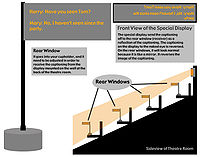
Rear Window Captioning System
Encyclopedia

Caption
Caption may refer to:*Caption , a small press and independent comic convention held annually in Oxford, England*Closed captioning, used to provide the text of a show's audio portion to those who may have trouble hearing it...
s, a transcript of the audio portion of a film
Film
A film, also called a movie or motion picture, is a series of still or moving images. It is produced by recording photographic images with cameras, or by creating images using animation techniques or visual effects...
in theatre
Theatre
Theatre is a collaborative form of fine art that uses live performers to present the experience of a real or imagined event before a live audience in a specific place. The performers may communicate this experience to the audience through combinations of gesture, speech, song, music or dance...
s for deaf and hard-of-hearing
Hearing impairment
-Definition:Deafness is the inability for the ear to interpret certain or all frequencies of sound.-Environmental Situations:Deafness can be caused by environmental situations such as noise, trauma, or other ear defections...
people. The system was co-developed by WGBH
WGBH-TV
WGBH-TV, channel 2, is a non-commercial educational public television station located in Boston, Massachusetts, USA. WGBH-TV is a member station of the Public Broadcasting Service , and produces more than two-thirds of PBS's national prime time television programming...
and Rufus Butler Seder.
On the way into the theatre, viewers pick up a reflective plastic panel mounted on a flexible stalk. The panel sits in a seat cupholder or on the floor adjacent to the seat. A large LED
LEd
LEd is a TeX/LaTeX editing software working under Microsoft Windows. It is a freeware product....
display is mounted on a rear wall
Wall
A wall is a usually solid structure that defines and sometimes protects an area. Most commonly, a wall delineates a building and supports its superstructure, separates space in buildings into rooms, or protects or delineates a space in the open air...
that displays caption characters in mirror image
Mirror image
A mirror image is a reflected duplication of an object that appears identical but reversed. As an optical effect it results from reflection off of substances such as a mirror or water. It is also a concept in geometry and can be used as a conceptualization process for 3-D structures...
. Viewers move the panels into position (usually below the movie screen) so they can read the reflected captions and watch the movie. It is sometimes necessary to sit in a certain area of the theater to obtain the best angle for reflecting the backward text emitted from the back of the theater on the panel while also being able to view the movie at the same time.
Through this method, all screenings of a film can be accessible to caption viewers. Others seated alongside do not watch, or usually even see, the captions.
Rear Window captioning is an alternative to open captioning, in which text is permanently visible. Open captioning has been little-used due to the fear that it was too intrusive and noticeable to hearing viewers. However, no studies have been conducted to elicit hearing people's opinions on how they will adapt to reading captions on screen. Rear Window captioning is a form of closed captioning
Closed captioning
Closed captioning is the process of displaying text on a television, video screen or other visual display to provide additional or interpretive information to individuals who wish to access it...
because the viewer must choose to view the captions.

For blind viewers, audio description
Audio description
Audio description refers to an additional narration track for blind and visually impaired consumers of visual media...
(Descriptive Video Service
Descriptive Video Service
The Descriptive Video Service is a major United States producer of video description, which makes visual media, such as television programs, feature films, and home videos, more accessible to people who are blind or otherwise visually impaired...
, DVS) can be and usually is transmitted along with captions. Viewers listen to the descriptions via wireless
Wireless
Wireless telecommunications is the transfer of information between two or more points that are not physically connected. Distances can be short, such as a few meters for television remote control, or as far as thousands or even millions of kilometers for deep-space radio communications...
headsets
Headphones
Headphones are a pair of small loudspeakers, or less commonly a single speaker, held close to a user's ears and connected to a signal source such as an audio amplifier, radio, CD player or portable Media Player. They are also known as stereophones, headsets or, colloquially, cans. The in-ear...
.
In the Rear Window system, the film print is unaffected. Captions and descriptions are distributed on a CD-ROM
CD-ROM
A CD-ROM is a pre-pressed compact disc that contains data accessible to, but not writable by, a computer for data storage and music playback. The 1985 “Yellow Book” standard developed by Sony and Philips adapted the format to hold any form of binary data....
that may be copied onto a computer. The computer plays the caption and/or description separate files synchronously with the film. With the transition to Digital Cinema, closed captions are included in many digital cinema package.
In many movie advertisements by a specific cinema, the "RWC" acronym is often used, much like the CC acronym is used to indicate the availability of closed captions on television shows. Often, "RWC/DVS" notation is used, indicating the availability of both Rear Window Captioning and Descriptive Video Service.

